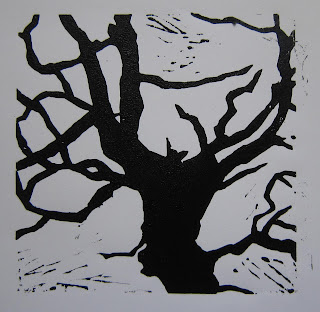Inspiration for this piece:
I took this photograph on a particularly cold and bright winter morning. I really like the silhouette of the branches against the sky. I reduced the image to black and white to emphasise the linear qualities of the tree shapes and to create a more graphic image which I thought would be a good place to start with making a mono lino print.
The Process of Lino Printing:
- Prepare the lino for cutting by glueing it securely and on the left hand side of a large piece of cardboard.
- Carefully measure registration markings by using the straight edge and corner the paper size you will be using. Create these registration markings by glueing pieces of lighter cardboard or card to the piece, as illustrated above.
- These are basic lino cutting tools widely available in art and craft supply stores.
- I also like to use a craft knife for detailed work or for when I want to keep edges sharp and clean.
- By attempting to keep this image as graphic and clean as possible I had to sacrifice some detail. The medium of lino was not suitable for a all of the detail contained within the original photo, so I kept the strongest components of the image whilst keeping the shapes of the print detailed as possible.
- The water based printing paint needs to be mixed with a palette knife on glass. A little water may be used if the paint begins to get too dry, however the paint must remain tacky and not runny.
- The paint, when of the correct consistency and colour, is rolled out using a printers roller.
- Placing a piece of paper over the print and cardboard backing, with a hole cut out for the print is advisable as this will stop the cardboard getting covered in paint and marking the finished prints, as demonstrated above.
- The paint is applied on the lino print in an even fashion, covering all raised pieces of lino evenly.
- Remove the paper, leaving only the print inked up.
- Carefully place the paper onto the print, using the registration markings as guides.
- Rub the paper onto the inked up lino. Use a wooden spoon to apply pressure evenly all over. This will ensure as much of the paint is transferred to the paper as possible.
- Remove carefully and place on a drying rack.
The Final Print:
I experimented with a couple of colours but I think the black on white paper looks the best. I am pleased with the crispness of the lines and the overall shapes achieved. Initially I did not want the lino markings in the white areas and was considering removing them further and re printing, but now I actually quite like the visual effect it achieves. I think the interesting contrast with the crisp black lines and white paper and how it reminds us of the actual technique. Without these imperfections the image might just look like a cut-out or stencil.










No comments:
Post a Comment